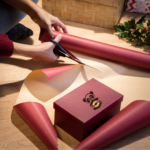Mylar vs Rigid Packaging : Which One You Should Choose?
Mylar vs Rigid Packaging has recently become new magic for different businesses, especially for consumer packaged goods brands. Good packaging enhances or tarnishes your brand’s identity. Hence, the selection process for one that caters to your needs should begin.
Mylar packaging and rigid packaging are the forefronts of several forms of packaging. But making a selection between one of these two for your brand can become puzzling. In the coming sections, we’ll explore Mylar vs. rigid in-depth and help you decide which type fits your customer’s needs-read until the end!
What is Mylar Packaging?
Mylar packaging has a rather colorful history. DuPont first used the trademark Mylar® in 1952 for plastic film packaging. As time went on, the term “mylar” became something of a catch-all for flexible plastic in the packaging arena. The term Mylar is commonly used for high-end plastic flexible packaging (PET). PET stands simply for polyethylene terephthalate.
If your customers want to have lightweight packaging that is versatile and strong enough to protect products, then Custom Mylar Bags for custom shapes will serve the purpose. With a mixture of metal and plastic, it keeps products fresh. This packaging has been built with resistance against harsh weather conditions such as moisture, light, oxidation, and air.
Already, with a view of the introduction to mylar packaging, you may want to follow with some information that you would use to define this kind of packaging-you can still read on.
Market Size of Mylar Packaging
Mylar packaging is projected to have a market value of USD 26.1 billion globally by 2032, according to the latest statistics on packaging. The study shows that be it any products across industries, the demand growth for mylar has pushed it to a level of preferred packaging..
Manufacturing
Another important thing, apart from market potential, is to know the manufacturing process so that you can figure out the costing and packaging procedures for mylar packaging. The film of mylar packaging is made from PET resin. This resin is then stretched in two opposite directions or axes to give it strength. Afterward, the foil film is sandwiched with aluminum foil, which has a very low oxygen transmission rate and prismatic reflection.More than that, the sheet is made adjustable and smooth by stretching it under high tension at 200 degrees Fahrenheit.
Afterwards, the top seal is provided with an efficient heating mechanism such as an iron or hair straightener.Then aesthetically picture mylar packaging with various printing options as demanded by the customers. There are many varieties of mylar boxes that consumers readily purchase- check them out!
4 Types of Mylar Packaging
- The Mylar packing bags can encompass any one of many, but four of these types are in demand due mainly to the versatility of use. The four common types are broken down as follows:
- Custom Mylar-shaped bags are for grain or dried food, vegetables, spices, snacks, and, of course, coffee. The vacuum sealing system does not allow oxygen and moisture to enter.
- They are flat-bottom pouches used for food and non-food items, including tea, powders, pet foods, cleaning supplies, and seeds.
- Child-resistant Mylar bags are made to withstand tearing and puncturing. They shield sensitive products from children and are used to package medicines, batteries, detergents, etc.
- Vista Mylar bags are trendy stand-up pouches. They hold herbs, tea spices, and dried flowers, as well as valuable metals, guns, and ammunition.
Pros and Cons of Mylar Bags
Mylar packaging has many advantages, but that doesn’t mean it is an ideal choice for packaging. Here is a brief rundown on the pros and cons of Mylar bags for you to decide whether they fit into your needs:
Pros
- Odor and Moisture Prevention: Mylar packaging has high barrier properties that keep things fresh. The barrier also prevents any odor from the cartons escaping.
- Child Safety: Child-resistant mylars have a unique airtight closing mechanism for keeping sensitive products such as medicines and detergents safe from children.
- Recyclable: Any Mylar material for packaging conforms to ISO packaging specifications. This is a plus for eco-friendly consumers; recyclable and reusable.
- Extends Shelf Life: These packages can extend shelf-life for more than five years with regard to consumables.
Cons
- Mylars are costly due to the special heating systems needed to ensure the effectiveness of packaging against moisture, air, and light. The plastic of mylar is neither sustainable nor friendly to the environment. If you must go biodegradable, these mylar bags will cost more.
- Uses of Mylar Packaging
- From indoors to outdoors, uses for mylar packaging penetrate different walks of life. Thus, with its versatility, more and more consumers are now interested in mylar bags and pouches. Some instances where mylar packaging show their best work are:
- Medical Emergencies: Mylar bags, in general, have so many applications, are lightweight, and are durable. These features make them excellent to carry everything for emergencies since mylar can exclude light and moisture from their interiors, thus safeguarding the medicine from contamination.
- Outdoor: Zip-lock mylar bags are good companions for camping, hiking, and holiday vacations as they are waterproof, windproof, and tear-resistant. Indeed, Mylar will make your trip and adventure memorable by keeping essentials safe against all adversities of nature.
- Pet Food: Treats and special diets for pets are a nightmare to keep fresh and free from moisture in packages. But the mylar bag offers properties that keep pet food usable for an extended period.
- Gardening and Planting: Mylar bags keep garden seeds fresh and usable for long. They are effective materials against air and moisture contaminations to keep seeds and other gardening supplies unspoiled.
What is Rigid Packaging?
Rigid packaging consists of extremely durable rigid materials such as plastic, paperboard, cardstock, and metals. The products packed inside rigid boxes cannot be deformed. Even the most tenuous of things are protected against bending, snapping, curving, or breaking by the very structural nature of rigid packaging.
Another reason firms prefer rigid packaging is because of its capacity to safely carry delicate products from transportation threats like knocks and bumps. Luxury items and products needing protection in transit are most often packed inside rigid boxes. This packaging will be a perfect choice for those companies who like both high-quality material and presentation packaging..
Market Size
An increased demand for rigid packaging among the consumer base has been witnessed. Newly concluded studies estimate that the global rigid packaging markets will reach a valuation of USD 704.24 billion by 2032. With such figures, it is very clear that rigid packaging is what brands prefer as opposed to all the other available options.
Manufacturing Process
The different types of materials that may be used in rigid packaging call for different manufacturing processes per material. Rigid packaging made of paperboard and cardboard is here briefly considered, as it is indeed the most common rigid packaging you will come across:
The basic structure of rigid boxes consists of a base of paperboard of thickness 2-3 mm, while the lid is wrapped with specialty paper. Steel cutting dies are used for cutting paperboard into the required size and shapes, followed by scoring dies, for folding the material into the basic structure.
The lid paper is then trimmed to size according to that of the interior paperboard, and the paperboard is glued to the lid. Once this basic structure has been prepared, it is printed, textured, and finished to achieve that luxurious appeal for the rigid boxes.
4 Types of Rigid Packaging
- Even though there is a myriad of options for rigid packaging, three types seem to boast more instances of application by clients. A brief overview of these three types of rigid boxes upon which businesses depend: Cardboard rigid boxes made from cardstock, can be easily customized.
- Hard-plastic rigid boxes are used for packaging high-end products.
- On the other hand, metallic rigid boxes are best suited for products that need maximum protection.
- Glass rigid packaging works well for liquids, i.e., medicines and perfumes.
Pros and Cons of Rigid Packaging
Just like mylar packaging, rigid packaging also has its pros and cons. Let’s explore both:
Pros
- Packaging is there to give an extra measure of strength to those delicate items and thus ensures that goods are not damaged during transit.
- It gives a beautiful aesthetic finish to the products, allowing for great consumer unboxing experiences.
- Plastic rigid packaging keeps food flavors intact and prevents contamination by dust and bacteria.
- Rigid packaging consists of recyclable materials like glass and hard plastics, thereby supporting better sustainability.
Cons
- Furthermore, shipping expenditures for rigid packaging are greater in cost, as this sort of packaging is considerable in weight, leading to an increase in overall freight charges.
Uses of Rigid Packaging
- Different types of rigid boxes are used in several industries according to each one’s unique purpose. You may have to check which rigid packaging material fits best with your customers.
- Food and Beverage: Glass jars, metal cans, and plastic containers preserve food flavor and keep food fresh for a relatively longer time. Therefore, rigid packaging is actually a good consideration for many premium food brands.
- Cosmetics and Skincare: These hexagonal cardboard boxes contain sensitive formulations of cosmetics and personal care items. The upper lid has premium luxury packaging, strengthening your brand positioning.
- Electronics: Since the polyurethane foam used on the inside provides high insulating properties, the rigid containers are suitable for the electronic appliance industries. They prevent damage and any chances of electronic products catching fire.
- Health industry: Rigid cardboard is non-toxic and suitable for packaging sensitive medications. It also offers a long shelf life and can keep medicines for longer periods.
Comparisons of Rigid vs Mylar Packaging
Mylar packaging is compared to rigid packaging at a parallel forum. This should give you insight on which to choose as end-user packaging.
Cost
Assuming it was an expression of fantastic considerations concerning the costly materials that make up rigid packaging, mylar would cost less than any other packing alternative. An instance could be that a small rigid box costs between $1 and $5, while mylar boxes are only pennies.
Strength and Durability
Rigid packaging triumphs in durability since it offers protection. However, mylar bags cannot be used for shipping products. The number one reason brands use mylar packaging is to preserve items from moisture.
Environmental Factors
Compared to rigid boxes, plastic and rigid mylar bags are recyclable. Paperboard and cardboard are biodegradable and thus prefer rigid boxes over other options. Mylar means plastic packaging, thus not so good to recycle if the aim is to achieve sustainability.
Consumer Preferences
Whenever the customer tends to think of luxury and durability, shrouds are the best option. On the other hand, if customers wish to acquire fresh and pristine products, whether for short- or long-term use, mylar bags serve well.
Styles and Designs
There is a multitude of styles and designs according to the choice of the customers. In such cases, one needs that particular type of packaging which exhibits flexibility in terms of customization and personalization according to the customer’s choice. The Mylar packaging is easier to customize in terms of styles and designs, considering its flexible plastic framing compared to the rigid cardboard.
Which Type of Packaging Should You Prefer?
We have discussed and compared rigid versus mylar in detail. Each type has its specifications and benefits. So if you were wondering which one works better for your consumer, you would weigh the benefits since there are no one-size-fits-all solutions.
Should you need more insight into what packaging would be best for your consumers? We welcome you to reach out for any inquiries. We’d also be happy to provide you with a free packaging quote to aid in your decision-making of the best option!
Conclusion
Depending on your business requirements, type of product, and budget, mylar or rigid packaging will suit you best. Mylar packaging, if lightweight, multipurpose, and affordable, is considered the way to go. It safeguards against moisture, air, and light.







